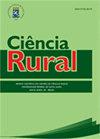VIS-NIR-SWIR反射光谱法检测甘蔗营养胁迫
IF 0.9
4区 农林科学
Q3 AGRONOMY
引用次数: 1
摘要
摘要:本研究利用高光谱数据,利用光谱辐射测定技术,研究了甘蔗叶片反射率与氮(N)、磷(P)、钾(K)、硫(S)、钙(Ca)和镁(Mg)含量的关系。在2019/20和2020/21收获期间,甘蔗通过施用石灰石剂量而受到营养胁迫。石灰是分次施用的,在5年结束时,石灰的用量分别为0、9、15和21吨/公顷。记录了指数生长期叶片高光谱反射率数据和营养物质状况。利用Spearman相关分析确定了与N、P、K、S、Ca和Mg相关的波长。采用相似性检验(ANOSIM)和主成分分析(PCA)评估数据的可变性,并采用偏最小二乘回归(PLSR)预测营养含量。在可见光区域的相关度顺序为:P > K > N > Ca > S > Mg,在近红外区域的相关度顺序为:P > K > Ca > N > S > Mg。P值在706 ~ 717 nm(-0.78)和522 ~ 543 nm(-0.76)处呈高相关性。在对缺硫、缺钾、缺磷较为敏感的VIS区和红边区,PLSR值的光谱响应最好。本文章由计算机程序翻译,如有差异,请以英文原文为准。
Detection of nutritional stress in sugarcane by VIS-NIR-SWIR reflectance spectroscopy
ABSTRACT: This study applied spectroradiometry techniques with hyperspectral data to identify the correlations between sugarcane leaf reflectance and the contents of Nitrogen (N), phosphorus (P), Potassium (K), Sulfur (S), Calcium (Ca) and Magnesium (Mg). During the harvests 2019/20 and 2020/21, sugarcane was introduced to nutritional stress by the application of limestone doses. Liming was applied in a fractional way and, at the end of five years, the amounts corresponded to 0, 9, 15 and 21 t ha-1 of dolomitic limestone. The leaf hyperspectral reflectance data and the state of nutrients in the exponential growth phase of the culture were registered. The wavelengths correlated with N, P, K, S, Ca and Mg were identified using the Spearman’s correlation analysis. The test of similarity (ANOSIM) and the Principal Component Analysis (PCA) were applied to evaluate data variability, as well as the Partial Least Squares Regression (PLSR) for the prediction of the nutritional contents. The order of the degree of correlation in the region of visible was: P > K > N > Ca > S > Mg and for the region of the near infrared: P > K > Ca > N > S > Mg. P presented peaks with high correlations in the wavelengths 706-717 nm (-0.78) and 522-543 nm (-0.76). The values of the PLSR registered the best spectral responses in the region of VIS and red-edge, regions that are more sensitive to the deficiency of sulfur, potassium and phosphorus.
求助全文
通过发布文献求助,成功后即可免费获取论文全文。
去求助
来源期刊

Ciencia Rural
AGRONOMY-
CiteScore
1.70
自引率
0.00%
发文量
233
审稿时长
2-4 weeks
期刊介绍:
The purpose of Ciência Rural is to publish the results of original research, note and reviews which contribute significantly to knowledge in Agricultural Sciences. Preference will be given to original articles that develop news concepts or experimental approaches and are not merely repositories of scientific data. The decison of acceptance for publication lies with the Editors and is based on the recommendations of Editorial Comission, Area Committee and/ or ad hoc reviewers. The editors and reviewers are external to the institution.
 求助内容:
求助内容: 应助结果提醒方式:
应助结果提醒方式:


